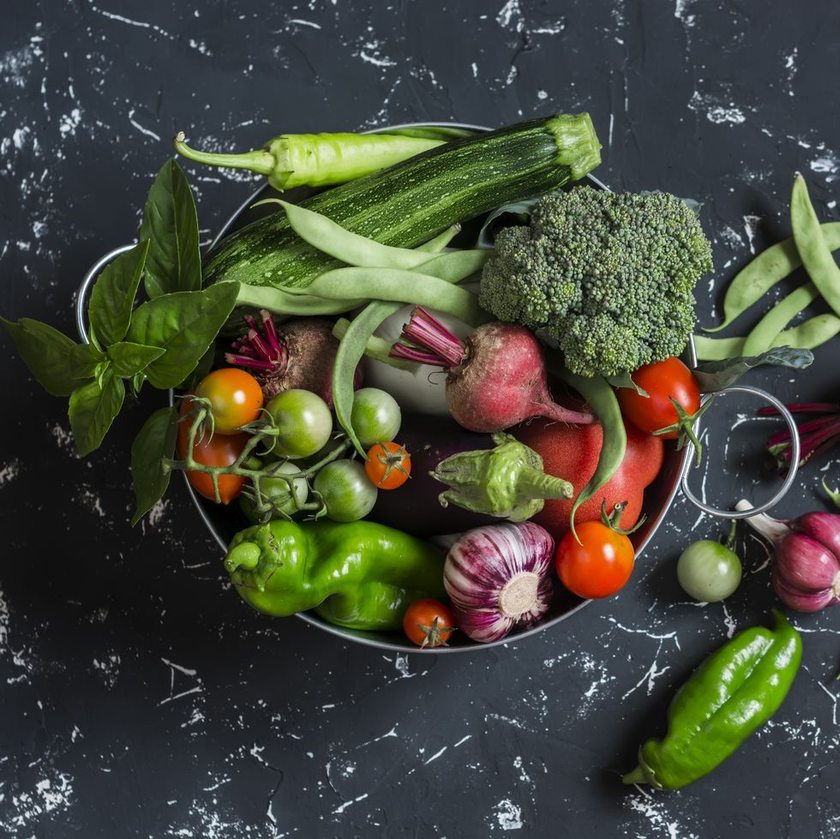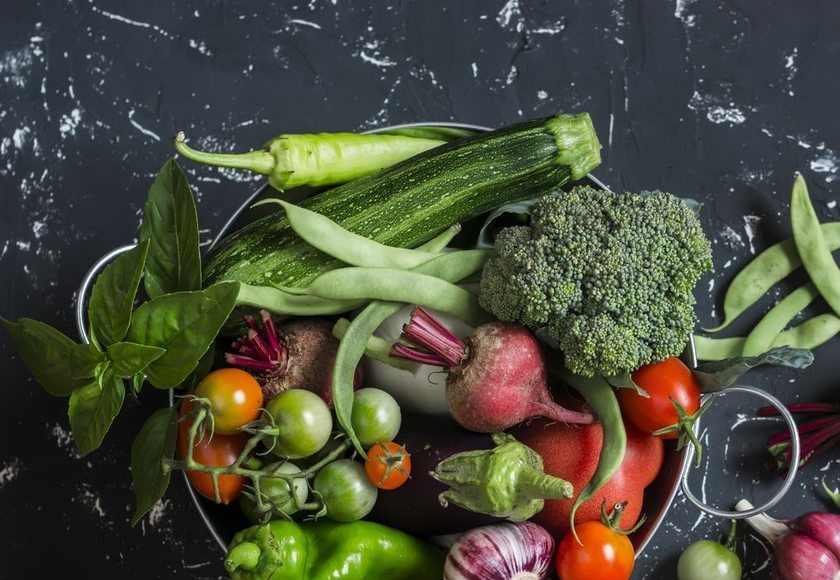The “clean-eating” craze has reached new levels of popularity — just check out the 58 million #EatClean posts on Instagram — but it’s a trend that’s been bugging me more and more lately, so I feel like it’s time to clarify a few things. Namely: What does “clean eating” even mean?
The phrase began with good intentions: It used to imply eating lots of whole, real foods — veggies, fruit, whole grains, animal and plant-based protein, nuts, seeds, and oils. It also meant you should eat as close to nature as possible — minimally processed, not packaged, or originating from a factory. Cooking at home and finding good ingredients were encouraged.
Related Stories
Drinking Celery Juice for the “Benefits” Is B.S.
Here’s Why Keto Diets Are B.S.
I do love that the original concept prompted an important question: Where does our food come from? So, if a clean eating mindset reminds you to read labels, check sources, and understand what’s what about the food you eat, I’d absolutely encourage you to keep that up.
To be clear: As a registered dietitian, it’s absolutely not my style to bash anyone else’s way of eating — ever! RDs like me are pretty gung-ho about the fact that our evidence-based opinions on what you eat are irrelevant unless you’re actively seeking our advice.
But these days, I’m worried that the phrase “clean eating” has taken on a new, misguided meaning. The implication is that if you’re not “eating clean,” what you eat otherwise is dirty, lazy, or unhygienic, and that’s simply not true.
It’s morphed from a sense of awareness about food into a diet-driven caste system. Not only does the phrase establish a hierarchical model for eating well, it’s yet another medium for food-shaming.
The part I dislike the most: It disregards the access — including time and money — required to find perfect, farmer’s market-fresh food. Frankly, it’s elitist. Instead of educating ourselves about food, we’re simply idealizing being thin above all else.
The other frustrating thing about “clean eating” is that the phrase misrepresents scientific evidence on food ingredients. More and more marketers refer to their food products as “clean.” But if your product is 90% full of a trendy version of oil or sugar, it’s still not providing consumers with healthful, educated choices.
Don’t believe me? Agave is no better for you than any other version of sugar; coconut oil is still a mostly saturated fat (even when your kale salad is doused in it); cold-pressed juice is still a concentrated source of sugar (and not very nutritious); and that vegan chocolate pudding is still dessert — not breakfast.
My bottom line is this: There are too many things that already make many of us — especially women — feel bad about ourselves. Nobody needs to take on the extra baggage of clean eating too. But in a world with countless product claims (especially on food) it’s hard to know how to make the best choices.
So, below are 10 important things to keep in mind when making healthy food choices:
1. Use social media as a resource, not a guidebook.
This may seem obvious, but it’s tougher than most of us realize! Use social media to inspire your health goals by considering which parts make it easier to eat more real, whole foods and which ones are just background noise that makes you feel confused instead of confident. The only thing to get rid of: generalizing. Just because one eating style works for one person, doesn’t mean it’s universally applicable to everyone.
2. “Healthy” is subjective.
It’s also highly personal, and it means something different to every single one of us. Emotional, mental, and physical well-being all play a part, but if you’re sacrificing one of those to prioritize another? That’s likely not your best bet.
3. More plants, more often.
Repeat after me: vegetables, vegetables, vegetables. That doesn’t mean “eat veggies only” or “all the time.” It means make more of your meals veggie-based, and the other components of a truly balanced diet will fall into place. When you can figure out how to make that work for you, obsessing about “clean versus dirty” becomes irrelevant.
4. Go beyond the (salad/smoothie/grain) bowl.
Enrique Díaz / 7ceroGetty Images
And on that note … “more plants” does not have to mean an Insta-worthy salad bowl all the time. In fact, salad can be a little sad, am I right?! Instead, consider tweaks that work with your lifestyle: What veggies can you add to your sushi order or sandwich delivery? Can you incorporate a piece of fruit to your snack? The goal is to add more to the foods you already love to make them more nutritious, delicious, and filling.
5. Think “transparent” over “clean.”
You know what I love about candy? It may not be ideologically aligned with #cleaneating, but it accurately represents itself as an indulgence. No one bought a candy bar thinking it was anything other than a treat! Transparent is a word I wish would take off, because it means being what it claims to be. Is your candy bar a candy bar, or is it pretending to be an energy bar?! If it’s the latter, put it back and go for the real thing.
6. Eat food, not food claims.
Brands make a lot of money by putting “health” claims on their products — some of which are totally legit, while others seem redundant (produce has always been gluten-free, for example). We derive better health from food, not simply from the individual nutrients that food contains.
7. Consider “whole” over “fresh.”
Fresh food is wonderful for all of the obvious reasons, but often we forget about items that are just as nutritious in their preserved state. Canned or frozen veggies, fruit, and lower-sodium beans, lentils, chickpeas and peas all retain their peak nutritional quality and cost a lot less. Focus on eating more real, whole food that’s as close to its natural, original version as possible. A combo of marketing and processing is what makes fresh oranges into fresh orange juice, so consider that when you check labels for sneaky, added sources of sugar, saturated fat, or sodium.
8. Stop treating all packaged food as the enemy.
bhofack2Getty Images
It’s easy for experts (myself included!) to say things like, “look for a short ingredients list or ingredients you can pronounce,” but there are some important exceptions. The best example: 100% whole-grain bread stuffed with tons of different 100% whole grains. Plus, quinoa and amaranth (two of-the-moment ancient grains) are downright unpronounceable for some.
Related Story
11 RD-Approved Snacks
So when it comes to packaged foods, consider this question: Are the ingredients in here, to the best of my knowledge, supposed to be in this product? Lots of exceptional packaged foods can lend a hand. Tuna in an air-tight pack, ready-to-eat hard-boiled eggs, and frozen cauliflower “rice” are all great examples.
9. Forget about the #CheatDay.
To date, this hashtag appears more than 3 million times on Instagram, but simply because it’s popular doesn’t mean it has truth to it. Indulging sometimes is 100% part of eating in a healthful way. While moderation is a trope in its own right, think of foods that taste great (but don’t always make you feel that great) as foods you eat “sometimes” — not “always” or “never.”
10. If you’re in a bind, think: easy, nutritious, delicious.
If making better-for-you food choices for you and your family is often a massive time, energy, and financial suck, ask yourself: How does any meal or snack make it easier to add more produce and maximize whole foods on your budget? Think of it in these terms, and more often than not, you’re already off to a great start.
Bottom line: Let’s vow to leave “clean eating” to what happens in your kitchen after you eat, not the food itself.











